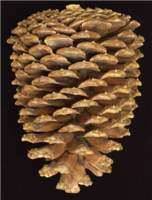Name
Pinus jeffreyi Balf., Bot. Exped. Oregon: 2 (1853).[Jeffrey pine]
Description
Habit: A tall tree to 60 m high, with a strait trunk and narrow, often spire-like crown. Trees of the Sierra Nevada origin tend to have sparser crowns with slightly more tufted foliage and a more cylindrical butt than those from the Coast Ranges.
Bark: In young trees smooth and pale grey, in older trees varying markedly according to origin. In trees of Coast Range origin it closely resembles P. ponderosa, being brownish grey to red-brown, fissured and irregularly flaked. In the Sierra Nevada race it is a darker grey, rough and has a much finer pattern of fissuring.
Foliage: Needles usually in groups of three (sometimes two to five) 11-26 cm long, 1.5-2.2 mm wide, usually bluish to greyish green, straight, stiff but flexible, sometimes twisted, with a tufted arrangement on the ends of the branchlets. Basal sheath persistent, dark grey-brown.
Branchlets: Stout, greyish at first, usually with a bluish white (glaucous) bloom in the first year or two, becoming grey-brown.
Winter buds: Cylindric, yellowish to reddish brown, non-resinous or occasionally slightly resinous, scales closely pressed at the bud tips, often free in the middle, fringed with whitish hairs.
Cones: Short-stalked or nearly stalkless, almost symmetrical to slightly asymmetrical, conical-ovoid to sub-cylindrical, 13-30 cm long, 8-18 cm wide when mature, dark purplish brown in the first year, becoming pale brown when mature. Scales transversely ridged, each with a small sharp spine, usually reflexed, thus the cone is not prickly to handle. Opening and shedding seed as soon as fully ripe, generally falling during the next few months. Cones relatively soft and light when dry. When cones are shed or picked a few scales often remain on the branch leaving a hollow in the cone base.
Seeds: Ovoid, 10-15 mm long, 7-8 mm wide, wing 2.5-3 cm long.
Notes
Pinus jeffreyi and P. ponderosa are closely related and can be difficult to distinguish but cones, are generally smaller and prickly to handle in P. ponderosa, and much less or not at all prickly in P. jeffreyi. Otherwise, resinous buds in P. ponderosa and non-resinous buds in P. jeffreyi are usually diagnostic. In young trees the colour of twigs, greyish to whitish in P. jeffreyi and brownish in P. ponderosa, is a valuable clue, particularly at times of the year when winter buds are not formed. A distinction also exists in the colour of the surfaces freshly exposed by flaking bark. In P. ponderosa it is a pale yellow, and in P. jeffreyi, a rich reddish pink. These two species can generally be distinguished from other pines by the combination of narrow regular crowns, sparse tufted foliage set near branchlet ends and deciduous cones.
Natural Distribution
Mexico, U.S.A.



